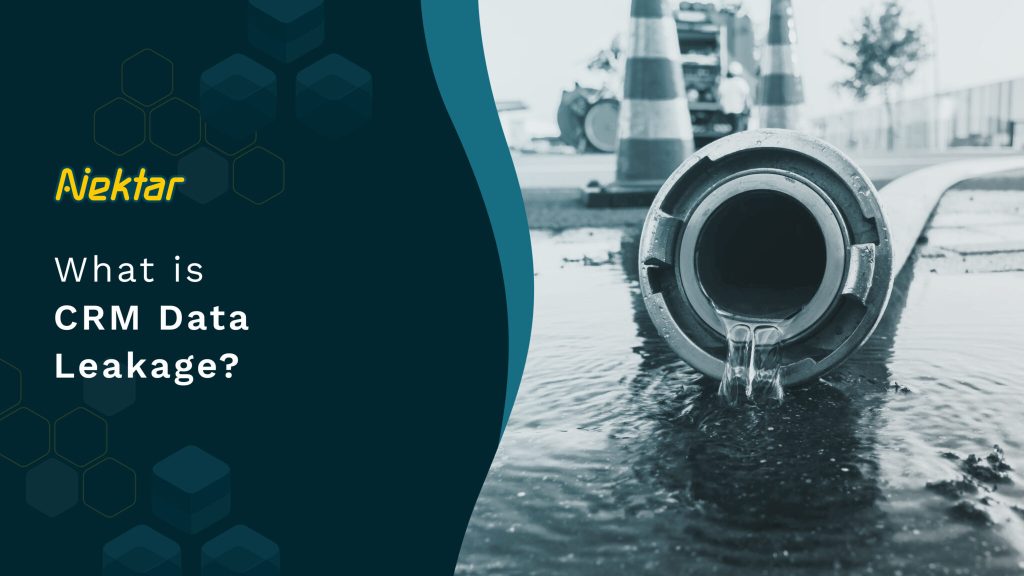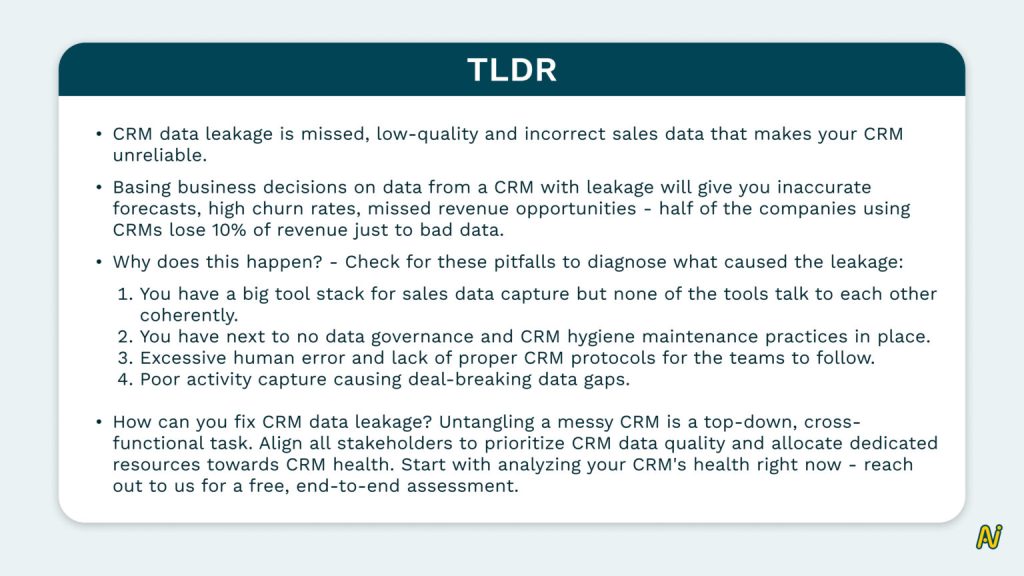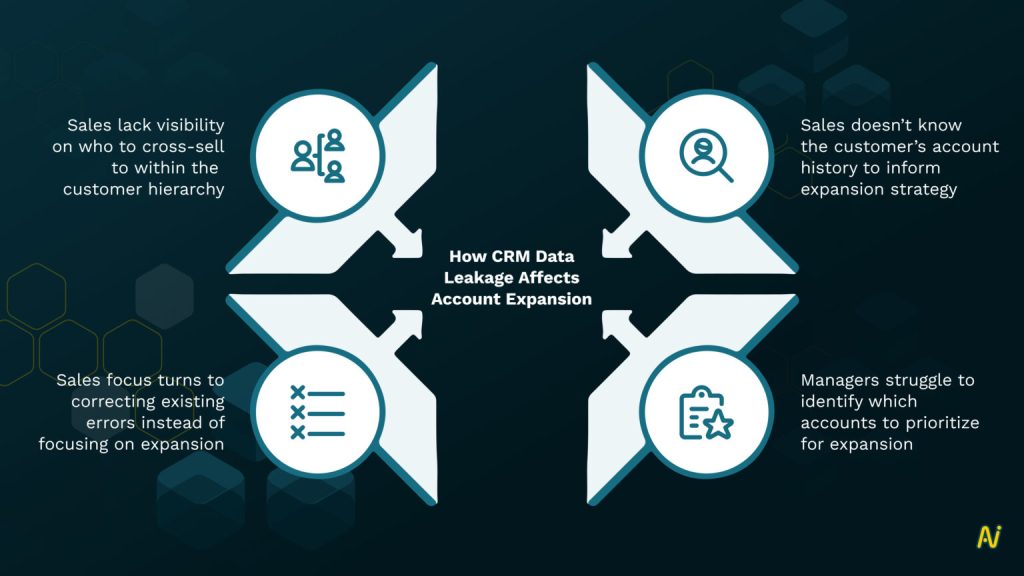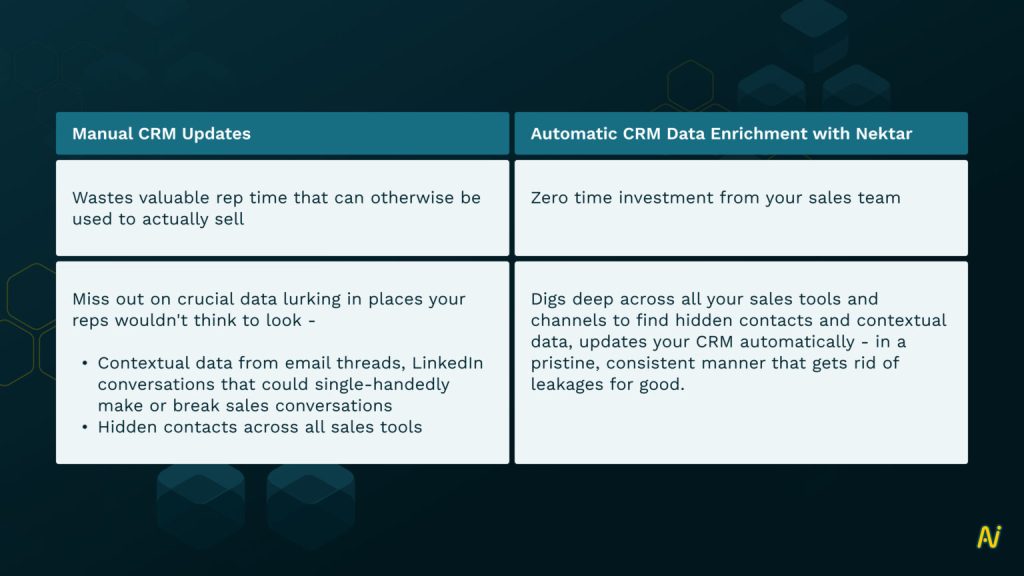
What is CRM Data Leakage?
This article explains what is CRM data leakage and why it needs to be addressed immediately within organizations to drive the revenue engine.
- CRM
- RevOps
It’s routine to check in on your pipeline and team performance in the CRM everyday. But did you ever stop to second guess if the data that facilitates crucial sales decisions is really all that reliable?
Your sales data determines your team’s daily course of action on every account, powers forecasts, and in turn upholds stakeholder trust. It keeps the bottom line moving. Yet half of all companies using CRMs lose 10% of their revenue just to poor data quality management.
In this article, we go over why your CRM’s data quality is pivotal, how to diagnose data leakage and fix it for good.

What is CRM Data Leakage?
CRM data leakage happens when low-quality or faulty sales data creeps its way into your systems – hampering productivity, forecasting, customer satisfaction and overall reliability of the CRM for the revenue teams. It’s simply bad CRM data quality costing you valuable time and money.
Reps missing out on high-potential opportunities to data leakage is more common than you think. If your CRM isn’t constantly checked for bad data and updated with new and enriched data – It’s just going to start working against you.
If your team doesn’t have a clear set of protocols for CRM data entry or it’s just low on the priority list – you’re probably losing a good chunk of revenue to it. According to a Gartner survey, companies lose an average of $14.2 million to data leakage annually.
Outdated lead contact data wasting your team’s time / human error in form entries are a couple of common examples.
Read more about the different ways leakage manifests itself in your CRM here.
Data leakage is fatal.
Alright – you might be missing some data in your CRM.
Is it really a ‘drop everything and fix this!’ problem?
Well, yes – it very much is.
Data leaks in your CRM cripple your entire sales function’s backbone – from missed follow-ups and wrong renewal information, all the way to skewed forecasting that affects your strategy going forward. Most importantly – your customers stop trusting your service.

Here’s an interesting account of how Blackberry lost millions of customers’ trust to bad CRM data hygiene. This marked the beginning of the end for them – like many other companies that overlooked data leakages.
Let’s see how bad data affects your sales effectiveness:
1. Wrong and missing intel
Make-or-break discovery insights that never made its way to the lead’s records. Outdated contract details, opportunities with little to no historical data. The CRM gives your reps the context they need to close deals with confidence. If they can’t rely on it, they’re on their own – and at a higher risk of losing out on revenue.
2. Forecasting horrors
Bad data in sales records will inevitably give you skewed forecasts, causing a huge ripple effect across your hiring, budgeting, risk management and business decisions at large.
3. Huge waste of time
Hubspot’s study found that 72% of reps spend at least an hour everyday entering and sorting through CRM data. Imagine the time they spend trying to fix data leakages on top of that. This makes them dread the CRM and dismiss it as busywork. It directly reduces adoption rates – which make the leakages worse. It’s a vicious circle of bad data.
4. Sky-high churn rates
You can’t properly assess churn risks in your current accounts without air-tight CRM data. Leakages cost you repeat business, which is the lifeline of any SaaS business. Only about one in four customer success reps use CRM data to understand their customers’ needs – mostly because they can’t trust it enough to base next steps on the insights.
While we’re talking about current customers, let’s also look into how much expansion revenue you lose to CRM data leakages.

5. Lost morale and leadership credibility in teams
Making key business decisions off of unreliable CRM data is like driving with faulty tires – there’s no way it doesn’t hurt the passengers. Over a third of all revenue leaders in this study said they can’t trust their CRM data, despite their company’s being ‘data-driven’.
If you make a bad call, it causes a domino effect all the way down to the junior reps in your revenue teams – hurting their performance and track records.
The Lurking Monster Bungling up your CRM
Duplicate records, invalid emails, decayed lead and opportunity info.
Phew! It’s a lot to weed through – but how did it get there in the first place?
Unless you know where the problem is stemming from, any solution is just slapping a band-aid on it. Poor governance is almost always one of the major drivers of data screw-ups as a company scales, but the problem could be much deeper than that.
Some common reasons you can look out for while diagnosing:
1. Siloed tools that have minds of their own
All tools plugged into your CRM via legacy connections gather data differently. While API connectors make them easy to access in one place, they don’t make them speak the same language – which is vital to make sure there are no data leakages. The problem worsens infinitely with less IT involvement in management of more no-techie friendly applications that let reps, sales team leads and CS teams configure core data settings to create even more inconsistencies in the CRM.
2. Poor data governance
What’s your usual frequency for a good old CRM data cleansing? Does the operations team have a solid governance process they follow? There is thousands of fields worth of data making its way into your CRM everyday. Without proper governance, you’re all but doomed to a bad case of leakage.
3. Activity capture gaps
There’s only one thing worse than having bad data. It’s having NO data. Missing data is probably the most detrimental leakage to have.
Sales communication happens all over the place – Zoom, LinkedIn, phone, text messages. It’s easy for a lot of important data to get mixed up in the tech and never find its way to your records.
Contextual knowledge is the lifeblood of SaaS sales. Incomplete data in opportunity records means:
- Sales team in the dark about contacts in the buying committee
- Inaccurate idea of how a deal is really coming along, judgment errors when deciding next steps
- Important deal info siloed across different tools and team members, accessing it becomes a painful process
All of which ultimately slows down your existing deals and prevents your team from pursuing potential revenue.
If this data is not flowing well from your sales tools to the CRM for everyone to access, your team’s making important calls with just gut instinct.
“We’re good on that front, we’ve got our CRM’s native activity capturing tool.”
If this is you – we’ve got news for you. You are certainly not good on that front – at all.
Take Salesforce’ Einstein Activity Capture as an example. It’s decent at capturing high-level data from tools plugged into Salesforce – but has some super counterproductive limitations.
EAC stores data on a different server altogether. You can’t pull reports to analyze from the data it captures – which makes it harder to share internally and inform business decisions. You have access to your invaluable sales data for 6 months by default and 24 months in the paid version – all of it is lost after that.
Fixing the CRM Data Leakage Mess
We’ve established that you need to set your CRM data straight to tap into otherwise missed revenue opportunities. How can you make that happen? Here are some steps to get started:
1. Align your organization to the ‘data hygiene’ mission
You’re going to need stakeholder buy-in to start the fixing process (and maintain it). Though it’s more than just getting them onboard for a routinely CRM clean up.
You can’t solve a problem as damaging as data leakage with half-hearted interim solutions. Maintaining good data is a continuous process.
2. Make well-informed structural changes
This is the quickest way to track down the biggest culprits causing data leakages – and it’s just as effective in showing where your CRM has been working well for you.
Identify your highest quality records and check for any structural elements that differentiate it. It could very well be a drop down that makes entry and access easier for your reps. Develop a plan to implement those winning structural elements across all your lead, opportunity and account records.
3. Put activity capture on autopilot
Updating my CRM is the bane of my existence as a sales rep
— Mo Money Mo (@momoneymohit) January 19, 2022
Your reps spend 5+ hours a week on a task that should ideally be 100% automated – updating the CRM. The human errors in manually updating that data is just a cherry on top. Unless your team is super careful, they risk overwriting information that’s pivotal for deals to close.
Imagine a world of no CRM admin work for your revenue teams. Whatever you imagined, it’s better than that.
“Five hours a week. It’s a potential of 10 demos… even at 20% close rate, two new deals per week, eight per month, times 40 reps… holy sh*t, that’s 320 new opportunities.”
Byron Sierra-Mattos, Team lead & senior account manager at apollo
That’s what CRM data leakages are costing you – not factoring in the disastrous long-term impact of misguided strategic decisions that bad data is bound to cause. We’ve been working to completely eliminate bad data from your systems – and busywork from your sales team’s lives.

